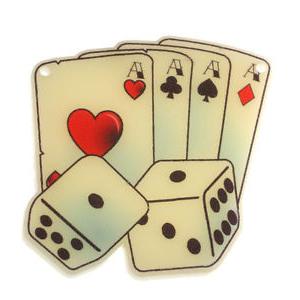At present, it is no longer possible to pinpoint the date of appearance of the first cubes and their author. A huge number of hoaxes on this topic are piled up in history, because many inventors attributed this primacy to themselves. However, the dice found by archaeologists, which is practically indistinguishable from the modern one, placed all points on the "i". This event occurred during excavations of the ancient Iranian city of Shahri-Sukhta, which existed more than five millennia ago. Complete with a cube was a board for playing backgammon, which indicates the popularity of this hobby in those days.
Origin
Prior to these events, the opinions of scientists about where the dice were invented diverged. Indeed, in the late historical works of India and Greece, there are references to the invention of the game of dice by specific people who, as it turned out, only presented a curiosity to the public. For example, representatives of Hellas stated that Palamed gave the bricks to bored soldiers who whiled away in time under siege of Troy. The ethnic group of India referred to the dismissive recommendations of the Buddha, who claimed that a self-respecting person would not plunge himself into the abyss of excitement and throw dice.
Local traditions
In the community of Kievan Rus, this fun underwent some transformations. The result was a game of "grandmother" - entertainment for children and women, which was aimed at developing dexterity. The dice in this case consisted of the vertebrae of ungulates, into which lead could be poured if necessary. Old Russian cubes largely inherited their ancestors, starting with the form and ending with their use.
Confession
In subsequent periods of history, the popularity of bones only increased. They were played by everyone who could afford it. Indeed, in a fit of excitement, it was possible not only to lose property, but also to spouse or even their own freedom, because in times of slavery such an outcome was more than obvious.
The Germans, the Byzantines, and later the Landsknechts were known as the most zealous players who deified this process of competition with fortune and, in order to attract her attention, decorated the bones with elaborate carvings. Cubes were made of precious wood, bone, and even metal. Already at that time of troubles, the first cheaters began to appear, who wanted to cash in at the expense of naive simpletons. In order for victory to always remain on their side, they weighted one side of the cube, as a result of which the dice acquired an offset relative to its center of gravity and the chance of some of its faces appearing was much higher. Also, since the eleventh century, the art of fortune telling has spread from the Eastern Roman Empire with the help of similar-looking chips. It was compared in popularity with traditional methods adopted earlier.

In the Middle Ages, numerous attempts were made to legislatively restrict cubes, but all of them ran into the tacit resistance of society and were only declarative in nature. As you can see, all these attempts were defeated, because the dice are still used in the gambling industry.
Modern application
Now standard cubes are all the same design that was used previously. However, for use in the casino, a certain standard was needed that would exclude fraud. Therefore, it was decided to unify all the small and large dice and accept only those whose face is 16 millimeters across. At the same time, as a result of checks of the probability of occurrence of some combinations, it was found out that when drilling points on the surface of the cube its center of gravity shifts. Therefore, modern dice are marked with color, which does not lead to the formation of distortions in the functioning of the source of randomness. Methods for marking the faces of the cube were also approved, the total amount of the three sides of which is always 7. When applying digital marks from 1 to 3 clockwise relative to the corner, these chips are called right, if vice versa - left.
Random number generator
It is precisely because of all these processes that a completely balanced dice, the probability of which each edge does not exceed 1/6, symbolizes blind luck and allows you to fully trust it. The results of the die roll are random, since this process is accompanied by many uncertain factors, starting with the position of the player’s hand and ending with his position or energy of movements. In a sense, this process can be called a random number generator, but their values will always be within certain limits. However, if there are doubts about the cube, then they can be easily dispelled - the dice is thrown twice, and the results obtained very rarely coincide. After all, the chips have rounded corners, which allows it to roll on the surface of the table with minimal resistance. Therefore, cubes are very widely used in the modern world, starting with gambling and ending with "Monopoly" or its analogues.